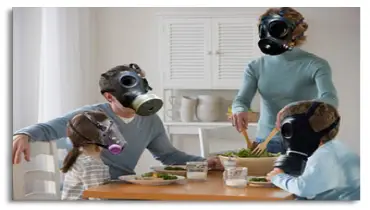Testing and Improving Indoor Air Pollution

The air we breathe leaves much to be desired. Power plants belch harmful carbon dioxide, automobiles churn out tons of exhaust fumes, and cows add methane to the air. Pollen tickles millions of people's noses and lungs. Sometimes just looking out your window at all the pollution may be enough to make you shun the outdoors. Can it be even worse inside your home?
Indoor air pollution, the degradation of indoor air quality by harmful chemicals and other materials, can be up to 10 times worse than outdoor air pollution. This is because confined areas enable potential pollutants to build up more than open spaces do. You can easily visualize this if you think about dumping a gallon of oil into the ocean versus dumping a gallon into your bathtub. The oil in the ocean will dissipate and be diluted within the massive volume of water. A gallon of oil in your bathtub will linger because it has nowhere else to go. The same thing happens with pollutants released into a small enclosed area like your home or office.
You may think indoor air concerns don't apply to you, but indoor air pollution comes from some places you wouldn't normally think of, like materials used to build your house, carpeting, the land it's sitting on, and everyday items you bring into the home. In addition, if you consider that people spend approximately 65 percent of their day inside their homes, you can see why indoor air pollution is an important issue.
Some of the side effects caused by indoor air pollution are a little worse than those of the common cold, but long-term exposure could lead to health issues, lung cancer, and even death. Got your attention, yet?
Learn more about the air you breathe inside your home with a simple air quality test kit. For about $80, you can purchase an Indoor Air Pollution test kit and see the results yourself. Look for a kit that tests for the presence of mold, fungus, bacteria, formaldehyde, carbon monoxide and carbon dioxide. Testing for radon requires a different test ($16 online, at radon.com ) but should be performed because exposure to radon is known to cause lung cancer.
After a wet, hot, and humid summer, the mold levels in homes may be alarming. If you have a constant sniffle or congestion, especially when you wake up in the morning, indoor air pollution could be a source. Once the test results indicate a cause of the contamination, corrective measures can be taken to reduce the amount of air pollution in your home.
The solution may be as simple as using a high-quality furnace filter (changed more regularly), having the air ducts cleaned, or replacing the moldy carpet in the basement.
If you are unable or do not desire to take these projects on yourself, Mr. Handyman is fully prepared to handle these and any other home repair and home maintenance services that require attention while we're in your home.
 Click to call
Click to call


